Which of the following is a hydrophobic material?
A) paper
B) table salt
C) wax
D) sugar
C
We can be sure that a mole of table sugar and a mole of vitamin C are equal in their
A) mass
B) volume
C) number of atoms
D) number of molecules
D
Measurements show that the pH of a particular lake is 4.0. What is the hydrogen ion concentration of the lake?
A) 4.0 M
B) 10-10 M
C) 10-4 M
D) 104 M
C
Measurements show that the pH of a particular lake is 4.0. What is the hydroxide ion concentration of the lake?
A) 10-10
B) 10-4
C) 10-7
D) 10.0 M
A
A slice of pizza has 500 kcal. If we could burn the pizza and use all the heat to warm a 50L contained of cold water, what would be the approximate increase in the temperature of the water? (Note: A liter of cold water weighs about 1 kg.)
A) 50°C
B) 5°C
C) 100°C
D) 10°C
D
Organic chemistry is currently defines as
A) the study of compounds made only by living cells
B) the study of carbon compounds
C) the study of natural (as opposed to synthetic) compounds
D) the study of hydrocarbons
B
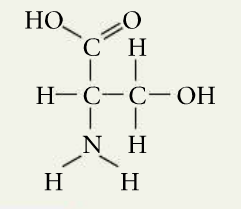
Which functional group is not present in this molecule?
A) carboxyl
B) sulfhydryl
C) hydroxyl
D) amino
B
Which chemical group is most likely to be responsible for an organic molecule behaving as a base?
A) hydroxyl
B) carbonyl
C) amino
D) phosphate
C
Which of the following hydrocarbons has a double bond in its carbon skeleton?
A) C3H8
B) C2H6
C) C2H4
D) C2H2
C
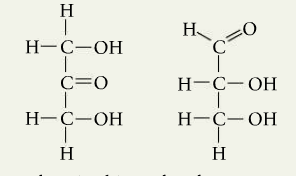
Choose the term that correctly describes the relationship between these two sugar molecules:
A) structural isomers
B) cis-trans isomers
C) enantiomers
D) isotopes
A
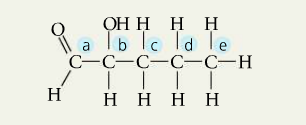
Identify the asymmetric carbon in this molecule
A) SEE IMAGE
B) SEE IMAGE
C) SEE IMAGE
D) SEE IMAGE
B
Which action could produce a carbonyl group?
A) the replacement of the -OH of a carboxyl group with hydrogen
B) the addition of a thiol to a hydroxyl
C) the addition of a hydroxyl to a phosphate
D) the replacement of the nitrogen of an amine with oxygen
A
Which of the following categories includes all others in the list?
A) monosaccharide
B) polysaccharide
C) starch
D) carbohydrate
D
The enzyme amylase can break glycosidic linkages between glucose monomers only if the monomers are in the α form. Which of the following could amylase break down?
A) glycogen, starch, and amylopectin
B) glycogen and cellulose
C) cellulose and chitin
D) starch, chitin, and cellulose
A
Which of the following is true of unsaturated fats?
A) They are more common in animals than in plants
B) They have double bonds in the carbon chains of their fatty acids
C) They generally solidify at room temperature
D) They contain more hydrogen than do saturated fats having the same number of carbon atoms.
B
The structural level of a protein least affected by a disruption in hydrogen bonding is the
A) primary level
B) secondary level
C) tertiary level
D) quaternary level
A
Enzymes that break down DNA catalyze the hydrolysis of the covalent bonds that join nucleotides together. What would happen to DNA molecules treated with these enzymes?
A) The two strands of the double helix would separate
B) The phosphodiester linkages of the polynucleotide backbone would be broken
C) The pyrimidines would be separated from the deoxyribose sugars
D) All bases would be separated from the deoxyribose sugars
B
The molecular formula for glucose is C6H12O6. What would be the molecular formula for a polymer made by linking ten glucose molecules together by dehydration reactions?
A) C60H120O60
B) C60H102O51
C) C60H100O50
D) C60 H111O51
B
Which of the following pairs of base sequences could form a short stretch of a normal double helix of DNA?
A) 5'-AGCT-3' with 5'-TCGA-3'
B) 5'-GCGC-3' with 5'-TATA-3'
C) 5'-ATGC-3' with 5'-GCAT-3'
D) All of these pairs are correct
C
Which structure is not part of the endomembrane system?
A) nuclear envelope
B) Golgi apparatus
C) chloroplast
D) plasma membrane
B
Which structure is common to plant and animal cells?
A) chloroplasts
B) central vacuole
C) mitochondrion
D) centriole
C
Which of the following is present in a prokaryotic cell?
A) mitochondrion
B) ribosome
C) nuclear envelope
D) chloroplast
B
Which structure-function pair is mismatched?
A) microtubule; muscle contraction
B) ribosome; protein synthesis
C) Golgi; protein trafficking
D) nucleolus; production of ribosomal subunits
A
Cyanide binds to at least one molecule involved in producing ATP. If a cell is exposed to cyanide, most of the cyanide will be found within the
A) mitochondrion
B) ribosomes
C) peroxisomes
D) lysosomes
A
What is the most likely pathway taken by a newly synthesized protein that will be secreted by a cell?
A) Golgi → ER → lysosome
B) nucleus → ER → Golgi
C) ER → Golgi → vesicles that fuse with plasma membrane
D) Er → lysosomes → vesicles that fuse with plasma membrane
C
Which cell would be best for studying lysosomes?
A) muscle cell
B) nerve cell
C) phagocytic white blood cell
D) bacterial cell
C
In what way do the membranes of a eukaryotic cell vary?
A) Phospholipids are found only in certain membranes
B) Certain proteins are unique to each membrane
C) Only certain membranes of the cell are selectively permeable
D) Only certain membranes are constructed from amphipathic molecules
B
According to the fluid mosaic model of membrane structure, proteins of the membrane are mostly
A) spread in a continuous layer over the inner and outer surfaces of the membrane
B) confined to the hydrophobic interior of the membrane
C) embedded in a lipid bilayer
D) randomly oriented in the membrane, with no fixed inside-outside polarity
C
Which of the following factors would tend to increase membrane fluidity?
A) A greater proportion of unsaturated phospholipids
B) a greater proportion of saturated phospholipids
C) A lower temperature
D) a relatively high protein content in the membrane
A
Which of the following processes includes all the others?
A) osmosis
B) diffusion of a solute across a membrane
C) passive transport
D) transport of an ion down its electrochemical gradient
C
Which of these experimental treatments would increase the rate of sucrose transport into a plant cell?
A) decreasing extracellular sucrose concentration
B) decreasing extracellular pH
C) decreasing cytoplasmic pH
D) adding a substance that makes the membrane more permeable to hydrogen ions
B
Binding of a signaling molecule to which type of receptor leads directly to a change in the distribution of ions on opposite sides of the membrane?
A) intracellular receptor
B) G protein-coupled receptor
C) phosphorylated receptor tyrosine kinase dimer
D) ligand-gated ion channel
D
The activation of receptor tyrosine kinases is characterized by
A) dimerization and phosphorylation
B) dimerization and IP3 binding
C) a phosphorylation cascade
D) GTP hydrolysis
A
Lipid-soluble signaling molecules, such as aldosterone, cross the membranes of all cells by affect only target cells because
A) only target cells retain the appropriate DNA segments
B) intracellular receptors are present only in target cells
C) only target cells have enzymes that break down aldosterone
D) only in target cells is aldosterone able to initiate the phosphorylation cascade that turns genes on
B
Consider this pathway: epinephrine → G protein-coupled receptor → G protein → adenylyl cyclase → cAMP. Identify the second messenger.
A) cAMP
B) G protein
C) GTP
D) adenylyl cyclase
A
Apoptosis involves all but which of the following?
A) fragmentation of the DNA
B) cell-signaling pathways
C) lysis of the cell
D) digestion of cellular contents by scavenger cells
C
Which observation suggested to Sutherland the involvement of a second messenger in epinephrine's effect on liver cells?
A) Enzymatic activity was proportional to the amount of calcium aded to a cell-free extract
B) Receptor studies indicated that epinephrine was a ligand.
C) Glycogen breakdown was observed only when epinephrine was administered to intact cells
D) Glycogen breakdown was observed when epinephrine and glycogen phosphorylase were combined
C
Protein phosphorylation is commonly involved with all of the following except
A) activation of receptor tyrosine kinases
B) activation of protein kinase molecules
C) activation of G protein-coupled receptors
D) regulation of transcription by signaling molecules
C
Through a microscope, you can see a cell plate beginning to develop across the middle of a cell and nuclei forming on either side of the cell plate. This cell is most likely
A) an animal cell in the process of cytokinesis
B) a plant cell in the process of cytokinesis
C) a bacterial cell dividing
D) a plant cell in metaphase
B
Vinblastine is a standard chemotherapeutic drug used to treat cancer. Because it interferes with the assembly of microtubules, its effectiveness must be related to
A) disruption of mitotic spindle formation
B) suppression of cyclin production
C) myosin denaturation and inhibition of cleavage furrow formation
D) inhibition of DNA synthesis
A
One difference between cancer cells and normal cells is that cancer cells
A) are unable to synthesize DNA
B) are arrested at the S phase of the cell cycle
C) continue to divide even when they are tightly packed together
D) cannot function property because they are affected by density-dependent inhibition
C
The decline of MPF activity at the end of mitosis is due to
A) the destruction of the protein kinase Cdk
B) decreased synthesis of Cdk
C) the degradation of cyclin
D) the accumulation of cyclin
C
In the cells of some organisms, mitosis occurs without cytokinesis. This will result in
A) cells with more than one nucleus
B) cells that are unusually small
C) cells lacking nuclei
D) cell cycles lacking an S phase
A
Which of the following does not occur during mitosis?
A) condensation of the chromosomes
B) replication of the DNA
C) separation of sister chromatids
D) spindle formation
B
A particular cell has half as much DNA as some other cells in a mitotically active tissue. The cell in question is most likely in
A) G1
B) G2
C) prophase
D) metaphase
A
The drug cytochalasin B blocks the function of actin. Which of the following aspects of the animal cell cycle would be most disrupted by cytochalasin B?
A) spindle formation
B) spindle attachment to kinetochores
C) cell elongation during anaphase
D) cleavage furrow formation and cytokinesis
D
The slight negative charge at one end of one water molecule is
attracted to the slight positive charge of another water molecule.
What is this attraction called?
A) a covalent bond
B) a
hydrogen bond
C) an ionic bond
D) a hydrophilic bond
E) a van der Waals interaction
B
The partial negative charge in a molecule of water occurs because
A) the oxygen atom acquires an additional electron.
B) the
electrons shared between the oxygen and hydrogen atoms spend more time
around the oxygen atom nucleus than around the hydrogen atom nucleus.
C) the oxygen atom has two pairs of electrons in its valence
shell that are not neutralized by hydrogen atoms.
D) the oxygen
atom forms hybrid orbitals that distribute electrons unequally around
the oxygen nucleus.
E) one of the hydrogen atoms donates an
electron to the oxygen atom.
B
Which of the following effects is produced by the high surface
tension of water?
A) Lakes don't freeze solid in winter, despite
low temperatures.
B) A water strider can walk across the surface
of a small pond.
C) Organisms resist temperature changes,
although they give off heat due to chemical reactions.
D)
Evaporation of sweat from the skin helps to keep people from
overheating.
E) Water flows upward from the roots to the leaves
in plants.
B
Which of the following takes place as an ice cube cools a drink?
A) Molecular collisions in the drink increase.
B) Kinetic
energy in the drink decreases.
C) A calorie of heat energy is
transferred from the ice to the water of the drink.
D) The
specific heat of the water in the drink decreases.
E)
Evaporation of the water in the drink increases.
B
A dietary Calorie equals 1 kilocalorie. Which of the following
statements correctly defines 1 kilocalorie?
A) 1,000 calories,
or the amount of heat required to raise the temperature of 1 g of
water by 1,000°C
B) 100 calories, or the amount of heat required
to raise the temperature of 100 g of water by 1°C
C) 10,000
calories, or the amount of heat required to raise the temperature of 1
kg of water by 1°F
D) 1,000 calories, or the amount of heat
required to raise the temperature of 1 kg of water by 1°C
E)
1,000 calories, or the amount of heat required to raise the
temperature of 100 g of water by 100°C
D
Liquid water's high specific heat is mainly a consequence of the
A) small size of the water molecules.
B) high specific
heat of oxygen and hydrogen atoms.
C) absorption and release of
heat when hydrogen bonds break and form.
D) fact that water is a
poor heat conductor.
E) higher density of liquid water than
solid water (ice).
C
Hydrophobic substances such as vegetable oil are
A) nonpolar
substances that repel water molecules.
B) nonpolar substances
that have an attraction for water molecules.
C) polar substances
that repel water molecules.
D) polar substances that have an
affinity for water.
E) charged molecules that hydrogen-bond with
water molecules.
A
One mole (mol) of glucose (molecular mass = 180 daltons) is
A)
180 × 10²³ molecules of glucose.
B) 1 kg of glucose dissolved in
1 L of solution.
C) the largest amount of glucose that can be
dissolved in 1 L of solution.
D) 180 kilograms of glucose.
E) both 180 grams of glucose and 6.02 × 10²³ molecules of glucose.
E
The molar mass of glucose is 180 g/mol. Which of the following
procedures should you carry out to make a 1 M solution of glucose?
A) Dissolve 1 g of glucose in 1 L of water.
B) Dissolve
180 g of glucose in 1 L of water.
C) Dissolve 180 g of glucose
in 180 g of water.
D) Dissolve 180 milligrams (mg) of glucose in
1 L of water.
E) Dissolve 180 g of glucose in 0.8 L of water,
and then add more water until the total volume of the solution is 1 L.
E
The molar mass of glucose (C₆H₁₂O₆) is 180 g/mol. Which of the following procedures should you carry out to make a 0.5 M solution of glucose?
A) Dissolve 0.5 g of glucose in a small volume of water, and then
add more water until the total volume of solution is 1 L.
B)
Dissolve 90 g of glucose in a small volume of water, and then add more
water until the total volume of the solution is 1 L.
C) Dissolve
180 g of glucose in a small volume of water, and then add more water
until the total volume of the solution is 1 L.
D) Dissolve 0.5 g
of glucose in 1 L of water.
E) Dissolve 180 g of glucose in 0.5
L of water.
B
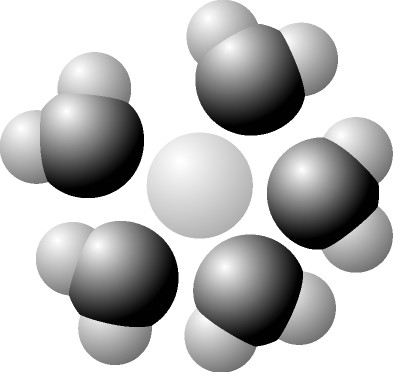
Based on your knowledge of the polarity of water molecules, the
solute molecule depicted here is most likely
A) positively
charged.
B) negatively charged.
C) without charge.
D) hydrophobic.
E) nonpolar.
A
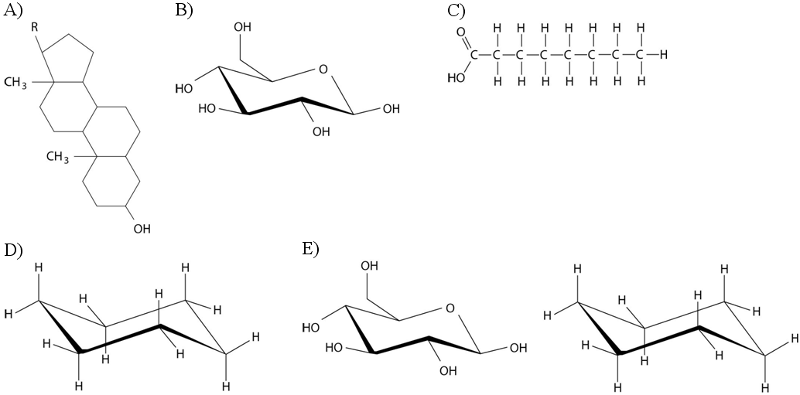
Which of these molecules would be soluble in water?
B
Testosterone and estradiol are male and female sex hormones,
respectively, in many vertebrates. In what way(s) do these molecules
differ from each other?
A) Testosterone and estradiol are
structural isomers but have the same molecular formula.
B)
Testosterone and estradiol are cis-trans isomers but have the same
molecular formula.
C) Testosterone and estradiol have different
functional groups attached to the same carbon skeleton.
D)
Testosterone and estradiol have distinctly different chemical
structures, with one including four fused rings of carbon atoms, while
the other has three rings.
E) Testosterone and estradiol are
enantiomers of the same organic molecule.
C
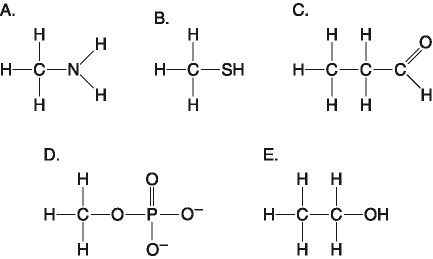
Which molecule shown above contains a functional group that cells use
to transfer energy between organic molecules?
A) A
B) B
C) C
D) D
E) E
D
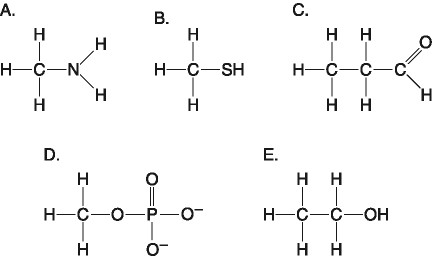
Which molecule shown above can function as a base?
A) A
B) B
C) C
D) D
E) E
A
Why are human sex hormones considered to be lipids?
A) They are
essential components of cell membranes.
B) They are not soluble
in water.
C) They are made of fatty acids.
D) They are
hydrophilic compounds.
E) They contribute to atherosclerosis.
B
What is the chemical reaction mechanism by which cells make polymers
from monomers?
A) phosphodiester linkages
B) hydrolysis
C) dehydration reactions
D) ionic bonding of monomers
E) the formation of disulfide bridges between monomers
C
The evolution of eukaryotic cells most likely involved
A)
endosymbiosis of an aerobic bacterium in a larger host cell–the
endosymbiont evolved into mitochondria.
B) anaerobic archaea
taking up residence inside a larger bacterial host cell to escape
toxic oxygen–the anaerobic bacterium evolved into chloroplasts.
C) an endosymbiotic fungal cell evolved into the nucleus.
D) acquisition of an endomembrane system, and subsequent
evolution of mitochondria from a portion of the Golgi.
A
The chemical reactions involved in respiration are virtually
identical between prokaryotic and eukaryotic cells. In eukaryotic
cells, ATP is synthesized primarily on the inner membrane of the
mitochondria. In light of the endosymbiont theory for the evolutionary
origin of mitochondria, where is most ATP synthesis likely to occur in
prokaryotic cells?
A) in the cytoplasm
B) on the inner
mitochondrial membrane
C) on the endoplasmic reticulum
D)
on the plasma membrane
E) on the inner nuclear envelope
D
A primary objective of cell fractionation is to
A) view the
structure of cell membranes.
B) sort cells based on their size
and weight.
C) determine the size of various organelles.
D) separate the major organelles so that their particular
functions can be determined.
E) separate lipid-soluble from
water-soluble molecules.
D
Which of the following is a major cause of the size limits for
certain types of cells?
A) limitation on the strength and
integrity of the plasma membrane as cell size increases
B) the
difference in plasma membranes between prokaryotes and eukaryotes
C) evolutionary progression in cell size; more primitive cells
have smaller sizes
D) the need for a surface area of sufficient
area to support the cell's metabolic needs
E) rigid cell walls
that limit cell size expansion
D
Which of the following statements concerning bacteria and archaea
cells is correct?
A) Archaea cells contain small
membrane-enclosed organelles; bacteria do not.
B) Archaea cells
contain a membrane-bound nucleus; bacteria do not.
C) DNA is
present in both archaea cells and bacteria cells.
D) DNA is
present in the mitochondria of both bacteria and archaea cells.
A
Recent evidence shows that signals from the extracellular matrix
(ECM) can regulate the expression of genes in the cell nucleus. A
likely mechanism is that
A) mechanical signals of the ECM can
alter the cytoskeleton, which can alter intracellular signaling.
B) intracellular signals might cause changes in the fibronectin
binding to the cell surface.
C) orientation of microtubules to
the ECM can change gene activity.
D) integrins that receive
signals from the ECM migrate to the nucleus.
E) proteoglycans in
the ECM undergo endocytosis and produce intracellular signaling molecules.
A
Signals between the ECM and the cytoskeleton may be transmitted
by
A) fibronectin.
B) proteoglycans.
C) integrins.
D) collagen.
E) middle lamella.
C
The sodium-potassium pump is called an electrogenic pump because it
A) pumps equal quantities of Na⁺ and K⁺ across the membrane.
B) pumps hydrogen ions out of the cell.
C) contributes to
the membrane potential.
D) ionizes sodium and potassium atoms.
E) is used to drive the transport of other molecules against a
concentration gradient.
C
Using the yeast signal transduction pathways, both types of mating
cells release the mating factors. These factors bind to specific
receptors on the correct cells,
A) which induce changes in the
cells that lead to cell fusion.
B) which produce more of the a
factor in a positive feedback.
C) then one cell nucleus binds
the mating factors and produces a new nucleus in the opposite cell.
D) stimulating cell membrane disintegration, releasing the
mating factors that lead to new yeast cells.
E) which in turn
releases a growth factor that stimulates mitosis in both cells.
A
Which of the following is characterized by a cell releasing a signal
molecule into the environment, followed by a number of cells in the
immediate vicinity responding?
A) hormonal signaling
B)
autocrine signaling
C) paracrine signaling
D) endocrine
signaling
E) synaptic signaling
C
In yeast signal transduction, the yeast cells
A) must
physically and directly interact.
B) produce signal molecules
that change themselves so they can interact with one another.
C)
produce response molecules that diffuse to other yeast cells.
D)
secrete molecules that result in response by other yeast cells.
E) mate, after which the new cells secrete hybrid signals.
D
When a neuron responds to a particular neurotransmitter by opening
gated ion channels, the neurotransmitter is serving as which part of
the signal pathway?
A) receptor
B) relay molecule
C)
transducer
D) signal molecule
E) endocrine molecule
D
Of the following, a receptor protein in a membrane that recognizes a
chemical signal is most similar to
A) the active site of an
allosteric enzyme that binds to a specific substrate.
B) tRNA
specifying which amino acids are in a polypeptide.
C) a
metabolic pathway operating within a specific organelle.
D) an
enzyme having an optimum pH and temperature for activity.
E) an
antibody in the immune system.
A
In general, a signal transmitted via phosphorylation of a series of
proteins
A) brings a conformational change to each protein.
B) requires binding of a hormone to a cytosol receptor.
C)
cannot occur in yeasts because they lack protein phosphatases.
D) requires phosphorylase activity.
E) allows target cells
to change their shape and therefore their activity.
A
In which of the following ways do plant hormones differ from hormones
in animals?
A) Plant hormones interact primarily with
intracellular receptors.
B) Plant hormones may travel in air or
through vascular systems.
C) Animal hormones are found in much
greater concentration.
D) Plant hormones are synthesized from
two or more distinct molecules.
E) Animal hormones are primarily
for mating and embryonic development.
B
In an experiment to track the movement of growth factor molecules
from secretion to the point of receptor binding in a particular
species of mammal, a student found a 20-fold reduction in mm traveled
when in the presence of an adrenal hormone. This is in part
attributable to which of the following?
A) The growth factor is
a paracrine signal.
B) The growth factor depends on osmosis.
C) The mammal only carries growth factor through the lymph.
D) The growth factor is an exocrine signal.
E) The growth
factor is an endocrine signal.
A
In the formation of biofilms, such as those forming on unbrushed
teeth, cell signaling serves which function?
A) formation of
mating complexes
B) secretion of apoptotic signals
C)
aggregation of bacteria that can cause cavities
D) secretion of
substances that inhibit foreign bacteria
E) digestion of
unwanted parasite populations
C
A strong acid like HCl
A) ionizes completely in an aqueous
solution.
B) increases the pH when added to an aqueous solution.
C) reacts with strong bases to create a buffered solution.
D) is a strong buffer at low pH.
E) both ionizes
completely in aqueous solutions and is a strong buffer at low pH.
A
Which of the following statements is true about buffer solutions?
A) They maintain a constant pH when bases are added to them but
not when acids are added to them.
B) They maintain a constant pH
when acids are added to them but not when bases are added to
them.
C) They maintain a relatively constant pH of approximately
7 when either acids or bases are added to them.
D) They maintain
a relatively constant pH when either acids or bases are added to them.
E) They are found only in living systems and biological fluids.
D
Buffers are substances that help resist shifts in pH by
A)
releasing H⁺ to a solution when acids are added.
B) donating H⁺
to a solution when bases are added.
C) releasing OH⁻ to a
solution when bases are added.
D) accepting H⁺ from a solution
when acids are added.
E) both donating H⁺ to a solution when
bases are added, and accepting H⁺ when acids are added.
E
One of the buffers that contribute to pH stability in human blood is
carbonic acid (H₂CO₃). Carbonic acid is a weak acid that dissociates
into a bicarbonate ion (HCO₃⁻) and a hydrogen ion (H⁺). Thus,
H₂CO₃ ↔ HCO₃⁻ + H⁺
If the pH of the blood drops, one would expect
A) a
decrease in the concentration of H₂CO₃ and an increase in the
concentration of HCO₃⁻.
B) the concentration of hydroxide ion
(OH⁻) to increase.
C) the concentration of bicarbonate ion
(HCO₃⁻) to increase.
D) the HCO₃⁻ to act as a base and remove
excess H⁺ with the formation of H₂CO₃.
E) the HCO₃⁻ to act as an
acid and remove excess H⁺ with the formation of H₂CO₃.
D